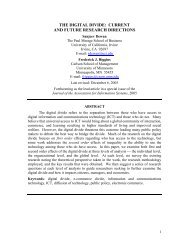When Should Software Firms Commercialize New Products ... - MISRC
When Should Software Firms Commercialize New Products ... - MISRC
When Should Software Firms Commercialize New Products ... - MISRC
Create successful ePaper yourself
Turn your PDF publications into a flip-book with our unique Google optimized e-Paper software.
while, under TLF, all low-type consumers get to use B in the first period. Given the large<br />
difference between the values of modules A and B, social welfare is maximized under TLF<br />
in this region.<br />
For all the feasible parameter combinations, under a profit maximizing firm, we dis-<br />
cussed in Theorems 1 and 2 which strategies yield the highest profit and the highest social<br />
welfare, respectively. We conclude this section by exploring opportunities for policy adjust-<br />
ments (e.g., subsidies) aimed towards aligning the firm’s and the society’s interests. We<br />
depict in Figure 4 regions whereaprofitmaximizing firm ends up choosing the strategy that<br />
actually yields the highest social welfare among CE, FLF, and TLF (we already know that<br />
SS and CS are dominated under both profit and social welfare). First, part (a) of Theorem<br />
2 shows that it is always desirable from a social standpoint for the firm to switch from a<br />
baseline CE model to a freemium model. Where CE is optimal for the firm, the highest<br />
social welfare is achieved under FLF or TLF depending on the values of γ and αb +δb, as<br />
illustrated in part (b) of Theorem 2. Second, when the firm chooses FLF, that strategy<br />
can yield the highest social welfare if and only if γ ≤ 1 (panels A.i, A.ii, and B.i of Figure<br />
4), i.e., when value added through module B is less than the value of module A. This case<br />
may correspond to scenarios where the firm offers a general multi-purpose platform product<br />
(module A) and allows users to purchase additional very specialized functionality separately<br />
(module B) which, on average, brings less benefits to users compared to the platform itself.<br />
Otherwise, social welfare can be increased by employing TLF in this region (panels A.iii,<br />
A.iv, and B.ii of Figure 4). Third, when the firm chooses TLF, that approach can be<br />
socially optimal only when αa ≤ γ+1<br />
2 and γ > 1 1<br />
3 . <strong>When</strong> γ ≤ 3 , FLF is socially optimal.<br />
<strong>When</strong> 1 1<br />
3 < γ <<br />
7−8φ(13−4 √ , FLF becomes less socially desirable as firm’s optimal choice<br />
10)<br />
(TLF) becomes socially better first for low αb+δb (Panel A.ii of Figure 4) and then also for<br />
1<br />
high enough αb + δb (panel A.iii of Figure 4). Ultimately, when<br />
7−8φ(13−4 √ ≤ γ (panel<br />
10)<br />
A.iv of Figure 4), firm’s optimal TLF choice is socially optimal for all αb + δb < 1 1<br />
2 + 2γ .<br />
Last, it is particularly interesting to note that when αa ≥ γ+1<br />
2 and γ > 1 the firm never<br />
chooses the strategy that maximizes the social welfare (TLF). In this scenario the firmdoes<br />
not want under any circumstance to invest into fully informing consumers about the true<br />
value of the product by completely forfeiting period 1 sales. This, in turn, may prompt the<br />
government to subsidize the firm in order to incentivize it to switch to TLF, thus educating<br />
customers about the product benefits.<br />
26
















